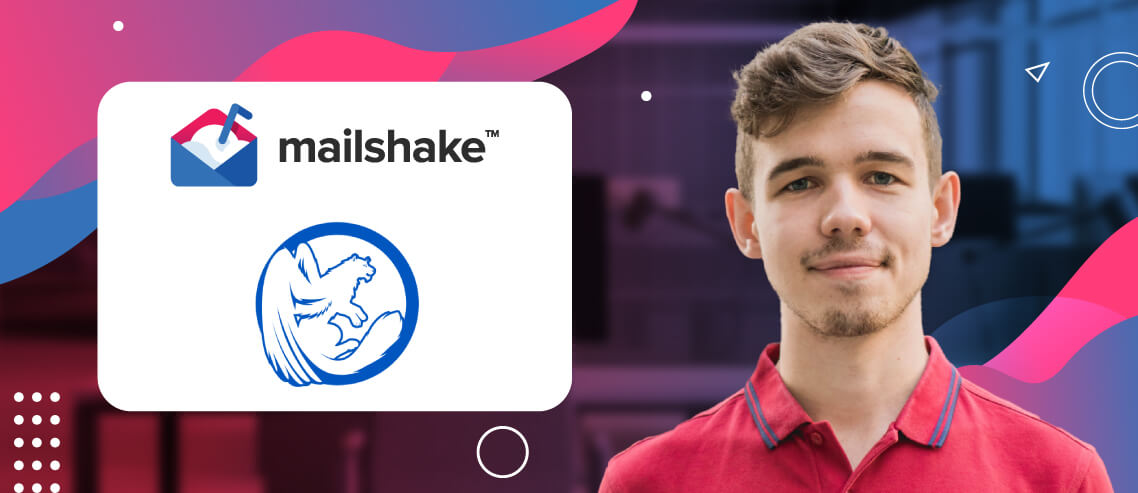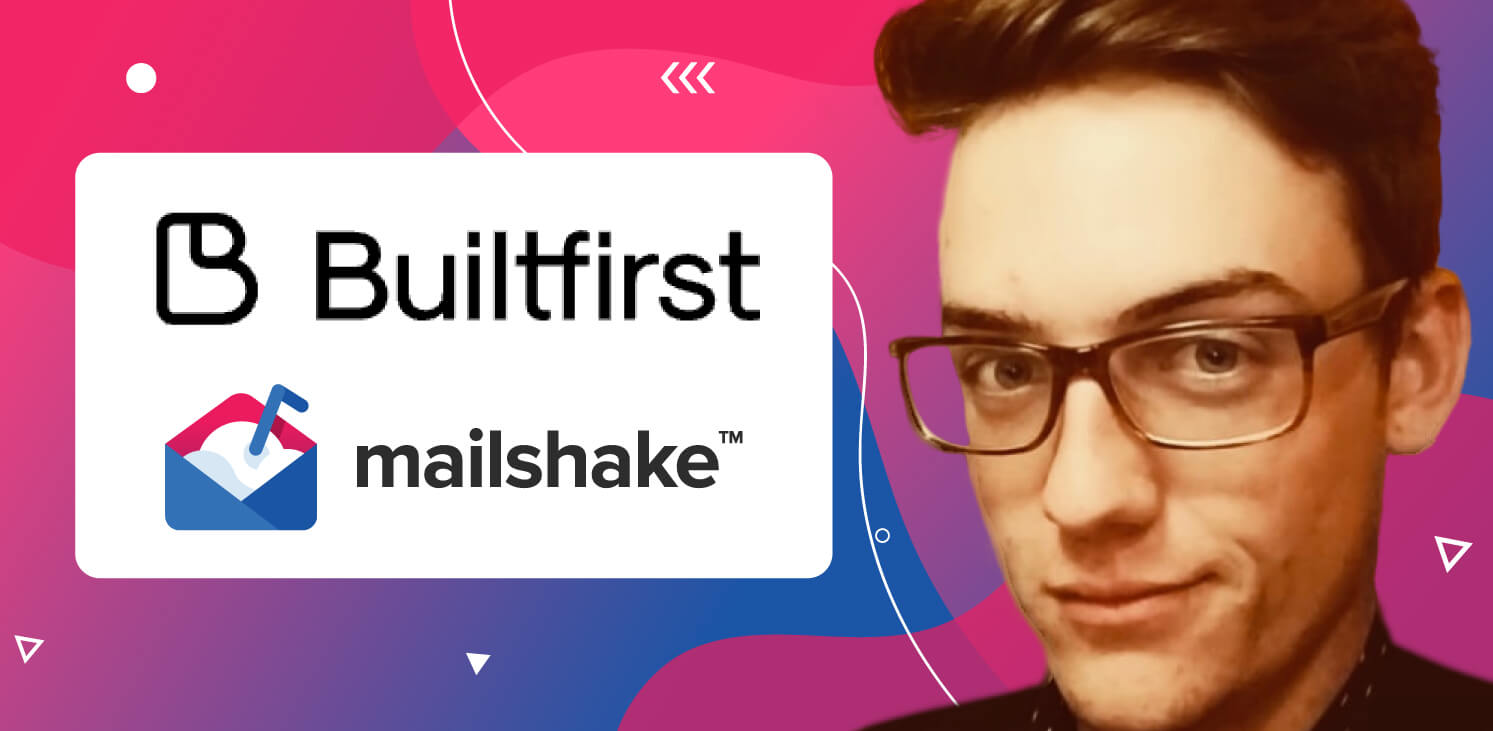[Case Study] How I Use Mailshake to Save a Ton of Time on Link Building Campaigns
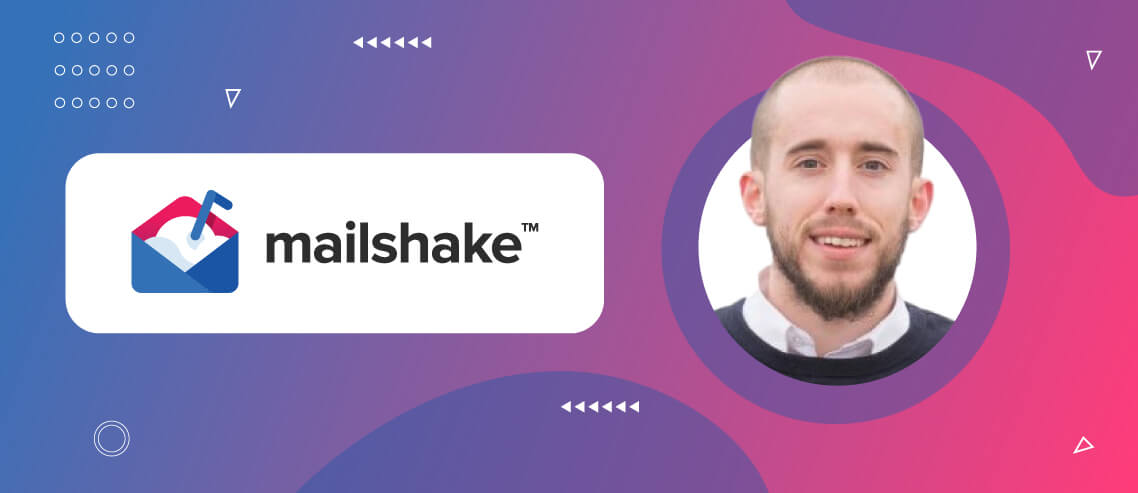
I build links for a living, and actually, I’m pretty good at it.
One of the biggest problems with truly white hat outreach campaigns is the absolute massive amount of time that they take.
If you want to rank your site in any moderately competitive niche these days you need to create remarkable content and build links from real sites that actually send traffic to your site.
In this post, I’m going to show you the exact process I used to build an insane number of links in a short period of time and used Mailshake to save myself a ton of time in the process!
The Background
I wanted to rank my website (smbclix.com) for the keyword “AdWords optimization” and I created a huge infographic that was jam-packed with actionable Adwords optimization tips for my outreach campaign.
I’ve used infographics to build really great links for both my own and my clients’ campaigns in the past and a huge fan of the Guestographic Method that Brian Dean wrote about and this case study is heavily based on that method with a few of my own little tricks thrown in, the biggest trick of all is using Mailshake for the outreach.
I’ll get to how Mailshake saved me so much time later in the article, but first, you need to understand some of the other key components for the success of the campaign.
The Strategy
If you are going to reach out to website owners to promote your content, then you need to build a solid list of people to reach out to. To do this you can use ‘The follow the leader approach’ and the ‘synonym method.’
The follow the leader approach is based around finding sites that have already linked to the same content (or very similar) as your content (in this case my infographic). For this to work, you will need a backlink tool such as Ahrefs or Majestic SEO.
Here’s the step by step:
My infographic was about Google Adwords, so I found other websites that have already featured infographics about AdWords.
One of the strongest ranking factors used in Google’s algorithm is links pointing to a post from other sites, so if a site is ranking for a keyword like “AdWords infographic, then it’s likely this site has some great links from some equally good sites and these sites are obviously already interested in AdWords infographics, as they’ve already linked to the sites ranking on page one.
So I started by Googling “Adwords Infographic”
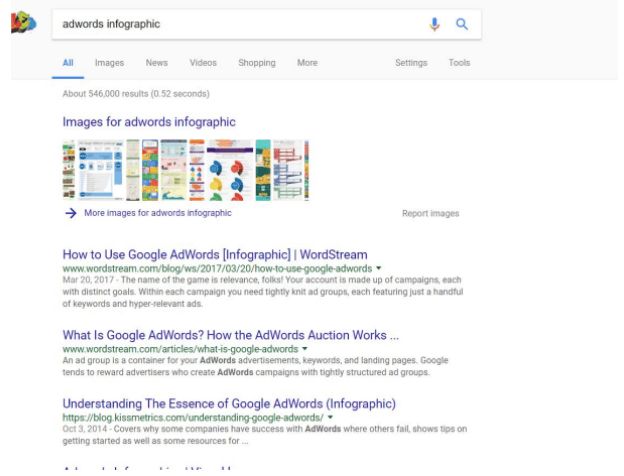
You can see from the results that the first result is a post from Wordstream.
To find some link prospects to reach out to, I found out who linked to the Wordstream post. I did this by taking the URL that was ranking and entered it into Ahrefs:

As you can see from my screenshot, there are 56 websites linking to this post, that’s 56 prospects who’ve already linked to someone else’s AdWords infographic, that might also like my AdWords infographic!

From here I clicked on the referring domains and filtered them down to sites that gave a dofollow link only and sorted them into the site with the highest domain rating first so that I’m targetted the sites that were most valuable first:
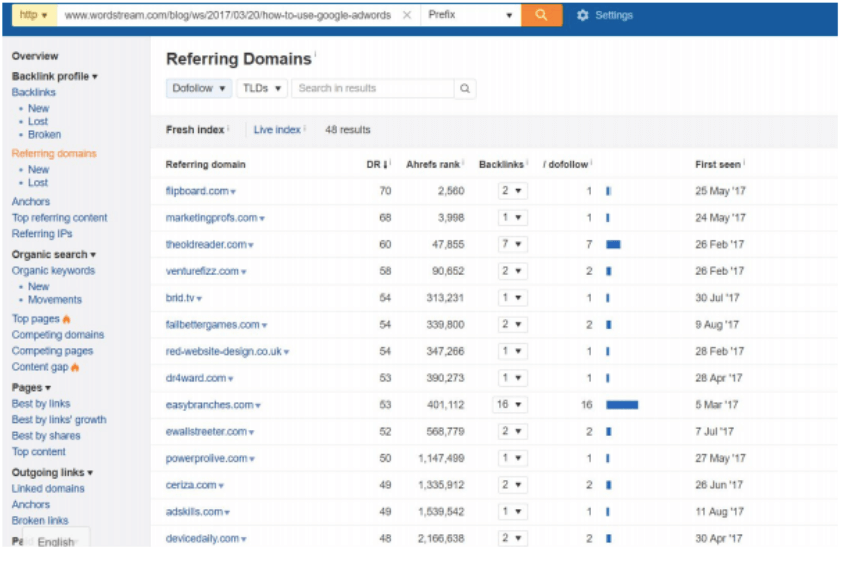
From there on I started to find the author of the post and build a list of all their contact details that I used to reach out to them and secure a mini guest post on their site using my infographic as linkbait.
The great thing about the follow the leader approach is that there are endless opportunities. In this example, I only showed you the links pointing to the very first result, but each result on the first page will produce endless link opportunities, as they all have links pointing to them from relevant sources, meaning I have hundreds of link prospects that I can find just from the first page alone.
I’m not going to get into the nitty-gritty on how I find the authors email addresses in this post, as there some awesome posts highlighting it and here’s one of ‘em!
The other method I used to build a list of prospects for my guestographic outreach campaign was to target other agencies like mine that I wasn’t in direct competition with, who might be likely to share content based on Adwords.
So, for instance, I don’t have an office in New York and I’m unlikely to get clients from there, but there are plenty of other AdWords agencies based in New York, that likely write about AdWords on their blog and might want to feature my infographic. I built this list by using search operators such as:
Keyword + city + blog
Keyword + city + bloggers
Inurl:blog city + keyword
Intitle:blog city + keyword
Then I used cities where I wasn’t the competition and keywords that were relevant such as AdWords, google adwords, ppc, pay per click etc.
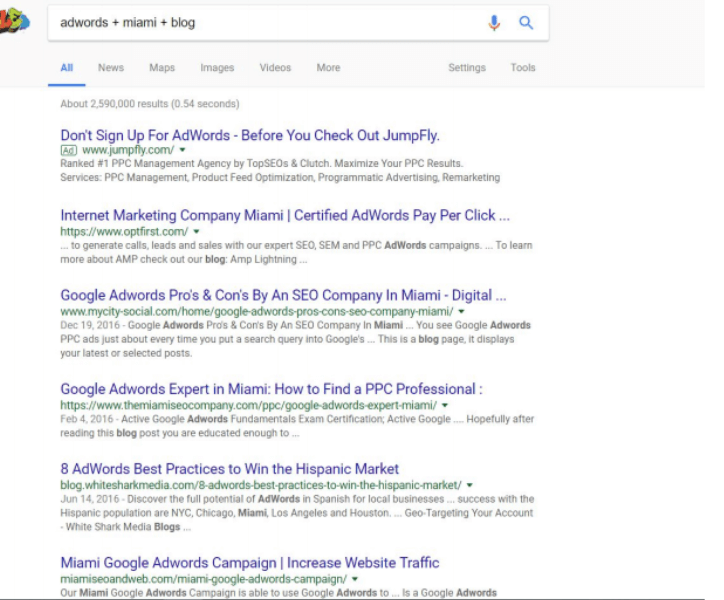
I usually use all of the search operators and go through as far as page 3 or 4 until I’ve found about 30 opportunities per city, during my regular research. For this task, I found relevant posts about AdWords on their site and recorded all of their details including the post URL and the author’s email address until I had a huge list of prospects that looked something like this:
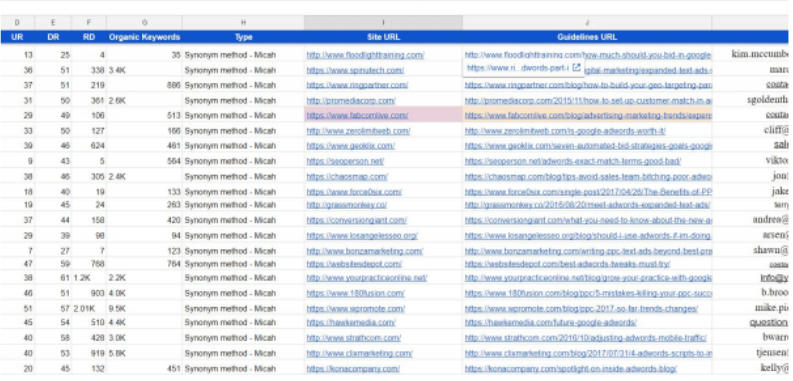
It’s important to note that I usually outsource the link prospecting tasks to a freelancer on a site like Upwork or PeoplePerHour, this way I spend more of my time on the outreach portion of the campaign.
Once I built my list, I continued with my outreach campaign and in case you haven’t already figured it out, Mailshake helped me save a great deal of time on this portion of the campaign!
The Mailshake Edge
Before I found Mailshake and started taking advantage of its awesome features I used to be able to send only 10-15 emails per hour maximum.
This meant that with an email list of 200 prospects to reach out and pitch my content to, it usually took me an average of 13-20 hours to reach out to everyone on my list. I used to use Gmail’s canned responses which saved me a bit of time, but to send a personalized email each time, I found it very hard to get past the 15 emails per hour mark.
With Mailshake I could send 200 personalized emails in about an hour, plus the follow-up sequences I could set using the tool probably saved me triple the amount of time!
The main way that Mailshake saved me time was through its ability to bulk upload the email list. Mailshake then generates the emails for you, you can ensure that each email is correct and personalize as needed. The ability to personalize the email got me some great responses, such as this one:
“Hey Michael, first I applaud your personal outreach email…way better than the generic crap I get most of the time. Lol”
Before each email is sent from Mailshake you can review it and personalize it. My emails included the person’s name, a link to the relevant content piece on their site and some more personalized details. By being able to personalize each email further, it increased the response rate. So, for example, I could add a line to my Email template that showed them I looked at their content. “I especially loved the part where you describe how XYZ increased ABC”
This handy video goes through the whole process of setting up your outreach campaign on Mailshake, including adding your list and personalizing each email.
The other main reason why Mailshake is so useful for outreach is its ability to automatically follow up when there is no response. So for example, I set up a sequence with 3 emails.
The first initial outreach email was along the lines of “Hey I saw your post about AdWords featuring the infographic from Wordstream, I’ve created a monster infographic containing 50 AdWords optimization tips. Would you like to see it?”
Obviously, it was more personalized than that, but you get the general gist of it. If the link prospects replied then great, Mailshake’s Lead catcher feature would capture and file the replies for me to respond to quickly.
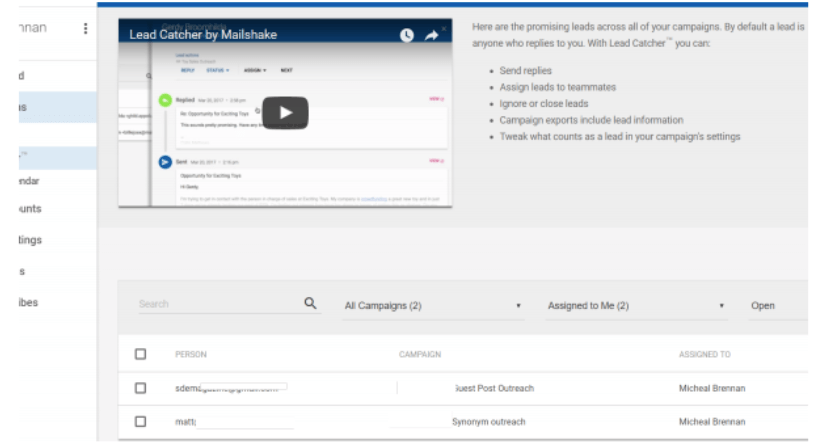
However, if they didn’t respond then Mailshake allowed me to schedule follow-ups to remind them about my Adwords infographic.
This is really great because, at the end of the day, people are busy, they might not get a chance to reply the first time round. In this campaign, the first follow up sequence (IE the second email) got me 5 additional replies and the second follow up sequence got me 2 additional replies. If I hadn’t followed up, I wouldn’t have got these replies and Mailshake allowed me to do this on autopilot.
I sent the initial outreach email complimenting their article and letting them know about my AdWords infographic. If I didn’t receive a reply after 3 days then Mailshake automatically sent the follow-up email which was along the lines of “Hey I just wanted to follow up, I don’t know if you saw my original email. I saw your article about AdWords, I’ve got an infographic about Adwords that I think you might like and I’d love to get your opinion on it”
Then finally after 2 more days (5 days after the original email) I sent one final email “Hey I definitely don’t want to spam you but I’ve created an infographic about Adwords that I think you would like, can I send it over to you, if not there’s no worries, this is my last follow up”
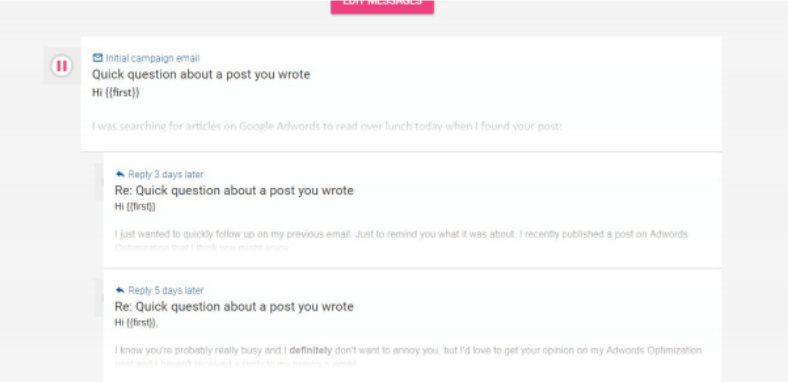
I split my outreach campaigns up into 2 separate campaigns but in terms of engagement from completely cold email the overall results were pretty awesome, check out the screenshots from the campaigns below:

The open rates were really high, the reply rates were pretty good as well and when you remove the emails that bounced from the equation, the reply stats are even better!

The overall campaign itself ran for about 3 weeks where I included initial email outreach, replies, writing mini guest posts and everything else that’s involved in a guestographic outreach campaign.
More important for an SEO outreach campaign than any of the stats above like opens and replies are the number of links built from the campaign: In the 3 week period, I built 13 links to my Adwords optimization post.
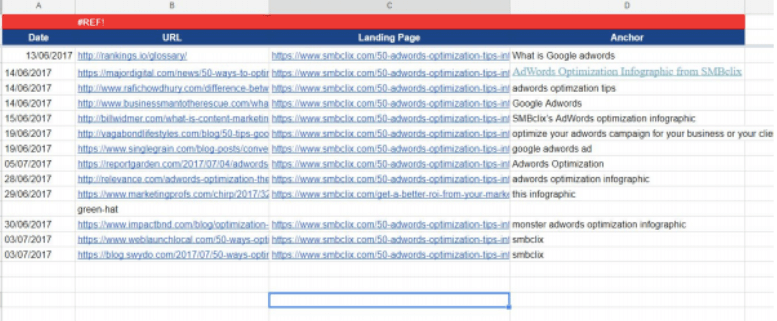
As a result, my AdWords optimization post shot straight to the second result on google.ie (I’m based in Ireland) and is steadily climbing on Google.com.

As I said previously, prior to using Mailshake to automate my outreach. I could usually send 10-15 initial outreach emails in an hour.
In this link building campaign, I sent 284 outreach emails in about one and a half hours. If you consider my previous speed when sending emails, this would have normally taken me close to 19 hours on a good day.
So Mailshake saved me about 17 hours of precious outreach time at the very least. Factor in the second and third follow up emails that Mailshake allowed me to send on autopilot and you are talking about nearly 56 hours in total that I didn’t have to spend sending emails as Mailshake did it for me! This is 56 more hours that I can now sell to my clients and grow my revenue.
My next outreach campaign is going to be for an infographic plus power page that I created on how to set up an adwords account.
I can’t wait to use Mailshake again to automate the entire process and give me back hours upon hours that I used to have to spend sending emails.
Mailshake is an awesome tool to use for SEO outreach, simple to set up and incredibly affordable, if you’re not using it then you are missing out big time!


